Mention the coastal town of Blouberg to Cape Town’s metropolitan elite and you’ll be met with a chorus of disapproval. “Too windy” one will sniff; “and so sandy!” another will chime. True enough about the wind I suppose, though the kite surfers don’t seem to mind. And they are certainly right about the sand; after all, this is where the Sandveld starts, home to one of the most dramatic episodes in the Cape’s ecological year – and it’s playing out right now.
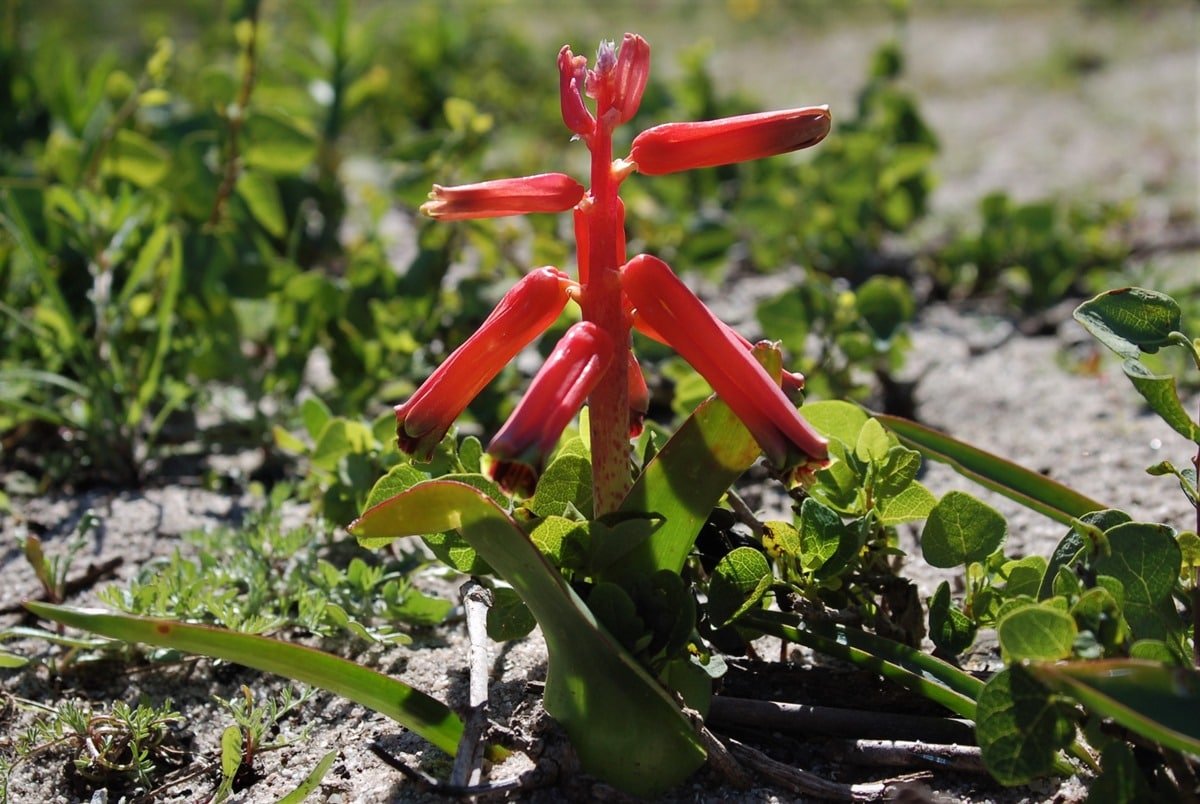
Lachenalia rubidia brightens up even the dullest of days in August; it’s in the Hyacinth family & known as a Sand Viooltjie – Sand Violet – in Afrikaans.
Named for its blue-tinged views of Table Mountain, Blouberg lies a 40-minute drive north of Cape Town on what is known as the West Coast – a modestly-sized area comprising a couple of hundred kilometres of Atlantic-battered coastline and its shrubby hinterland. But – and this probably won’t surprise you – the West Coast is home to a list of plants that rivals the number of species found in the British Isles and has a higher rate of endemic plants than the Cape Peninsula, itself a global hotspot of floral endemism.
It’s hard to believe my claims if you visit Blouberg in mid-summer when the Cape’s heat, wind and aridity are at their peak. But let the winter rains soak the sand and by August things have changed completely. Gone are the bare dunes and brown-stalked flatlands; the West Coast is now a riot of colour as flowers of all description charge out of the sand for a brief but glorious stand in the sun.
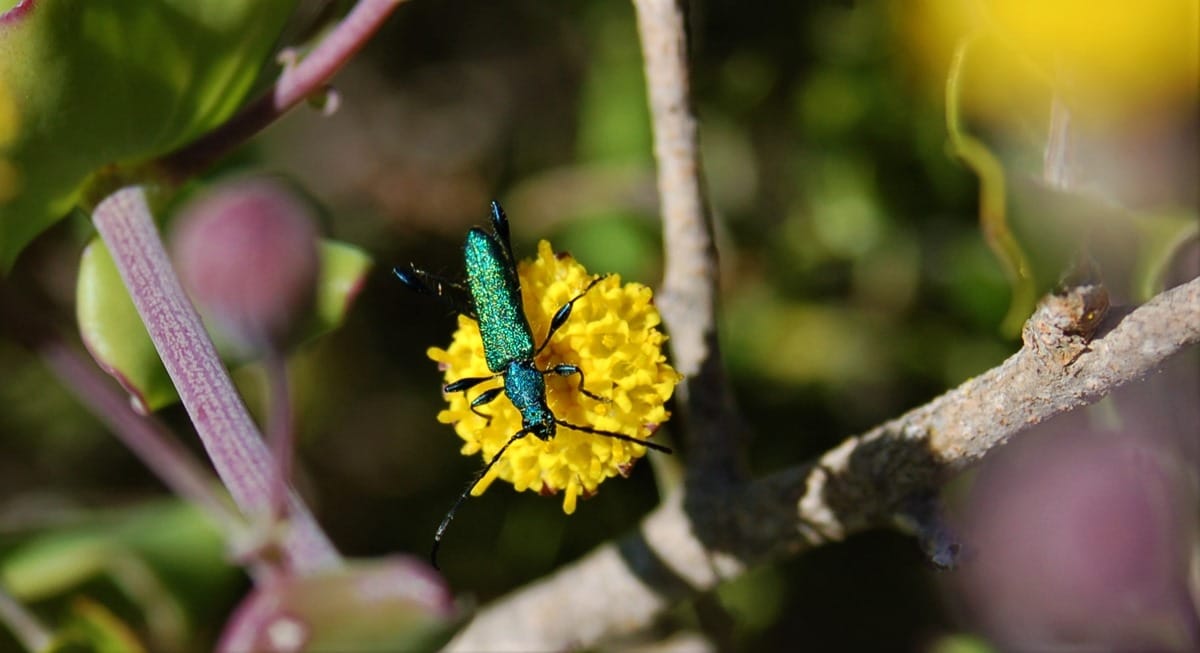
Often seen in Sandveld, Common Metallic Longhorn beetles (Promeces longipes) love yellow flowers – this one is a daisy.
The natural vegetation here is dominated by Sandveld, pronounced ‘Sunned Felt’ It’s a type of lowland fynbos in which you’ll find plenty of Restios (the Cape Reeds) but rarely the Protea and Erica (heather) elements you’d normally associate with mountain fynbos. Growing on deep, nutrient-poor sands of recent marine origin (rather than deriving from the local sandstone mountains) the Sandveld blends into other vegetation types such as Strandveld and Renosterveld as it weaves its way around the different geologies of the West Coast.

Tall Restios indicate the presence of Sandveld but the dunes support bushier Strandveld while the hill behind is covered in grassy Renosterveld vegetation.
It makes for a highly diverse set of plants and the landscape also supports more animals and birds than you’d find in the high mountains, something that is obvious when you visit the famous West Coast National Park and see antelope, zebra and ostrich happily grazing away next to the ocean. But you don’t have to go that far. There are plenty of flowers around the Blouberg area and if you make your way to the Erstesteen picnic site on Otto du Plessis Drive then you’ll have to be careful not to trample all over them when you get out of the car. There’s a small nature reserve behind the coastal dunes with a circular walk and the flowers are so prolific that you don’t even need to leave the path to see them.
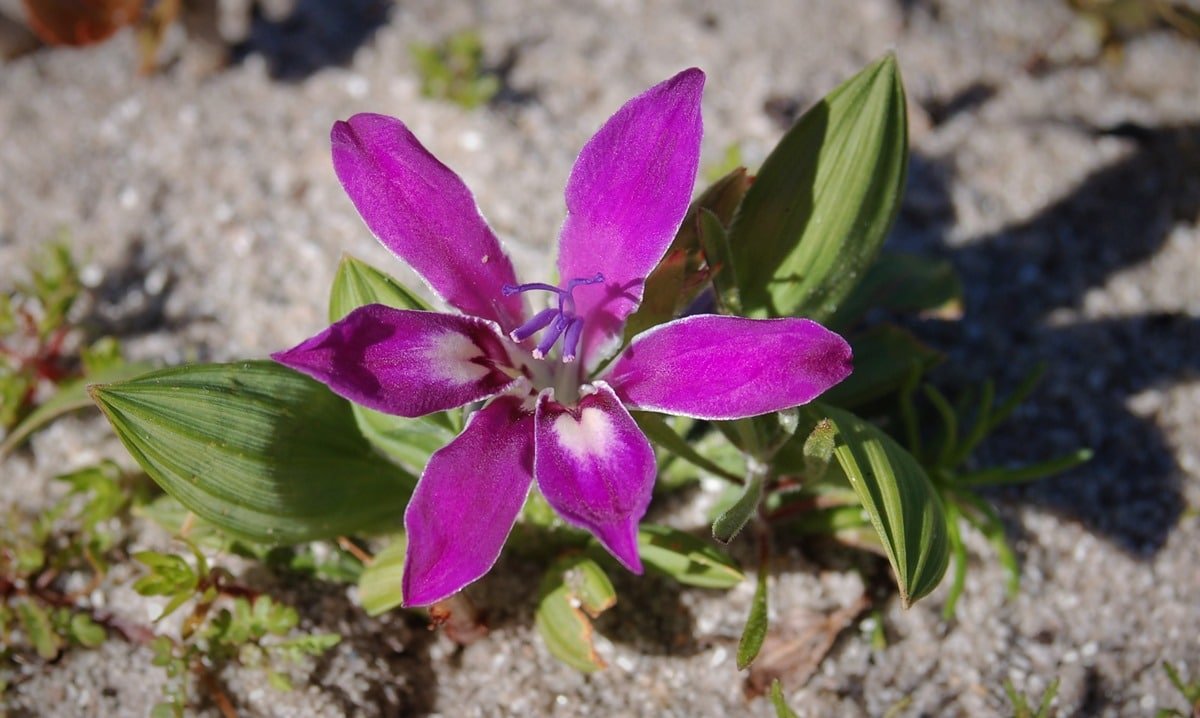
An explosion of purple reveals Babiana nana, an Iris whose underground corms are dug up & eaten by baboons.
Sandveld has a unique character to it; it is obviously not as florally diverse as the fynbos a few miles away on Table Mountain and it is often dominated by monotypic stands of thick bushes – notably Blombos (Metalasia muricata) and Trichocephalus stipularis, known as Dog Face in English but Hondegesiggie in Afrikaans – best pronounced in private if you are not an Afrikaans speaker. It does, however, have a couple of botanical aces up its sleeve.
The first is that the Sandveld supports great numbers of annuals – the type of plant that only lasts a year (and usually absent from mountain fynbos). Mostly in the Daisy and Figwort families (Asteraceae and Scrophulariaceae if you’d like to get technical), these annuals are responsible for the sheets of colour you see swaddling the roadsides in the Cape late winter. The daisies are obvious to pick out thanks to their simple flowers and bright primary colours but if it’s a bit of a weirdo flower you’re looking at, then chances are it’s a ‘Scroph’.

A typical West Coast scene in August & September – massed annuals of the Daisy family.
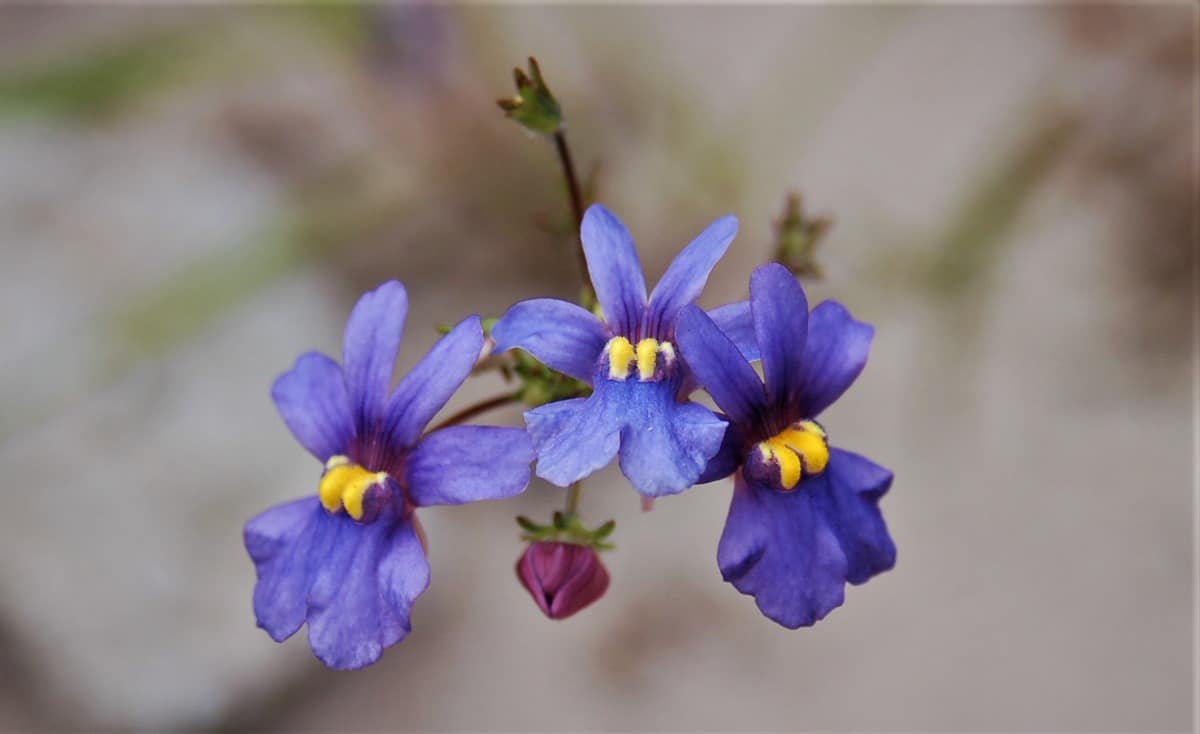
The Cape Snapdragon (Nemesia affinis) is a ‘Scroph’ & is called a Leeubekkie in Afrikaans – Lion Mouth.
The other trick is that the Sandveld goes big on perhaps the most interesting and enigmatic plants of all – the geophytes. Spending most of their life underground as – for example – a bulb, the geophytes contain some real beauties and many are shockingly rare. You’ll know some of them – Gladioli and Freesias, Arum lilies and Hyacinths – but most will be new, even if you are familiar with fynbos bulbs.

Like wispy ghosts, the pale petals of Babiana tubulosa rise out of the sand, sometimes painted with red chevrons, sometimes not.
The very earliest European explorers to the region reported evidence of large animals – even elephants – in the Sandveld but cattle ranching and agriculture have taken over the most productive areas, especially in the interior where the shale and granite soils are fertile. Lower your expectations for animals however and you will be rewarded in the Sandveld; during my last walk in the Blouberg Reserve I saw tortoises, mongooses and a Cape grysbok (a small, twitchy-eared antelope) as well as many insects and birds, filling the air with pleasant hums, buzzes and whistles.
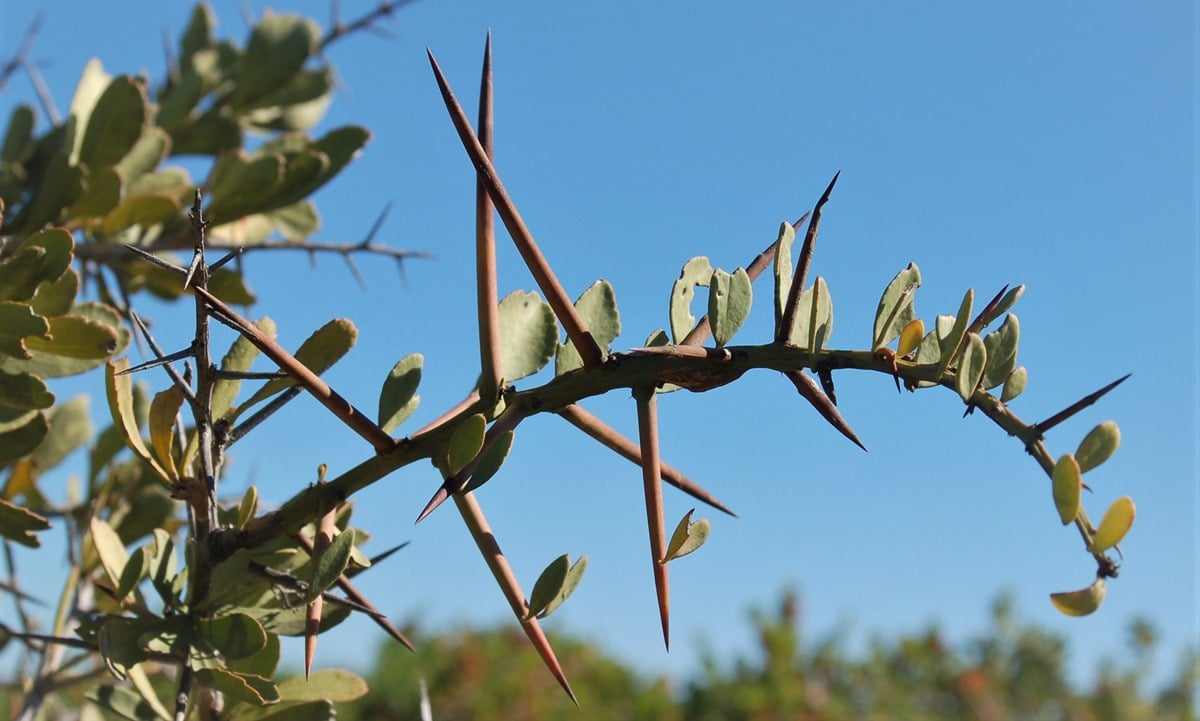
Big aggressive thorns are an indicator of Strandveld plants: they once had to defend their nutritious leaves against large herbivores such as eland & buffalo.

Angulate tortoises (Chersina angulata) are relatively common in the Cape’s coastal habitats & why not – South Africa has the world’s highest diversity of tortoises.
And had I been walking there 500 years ago, I would have heard human sounds too, not that I would have understood them. The indigenous Khoisan would have been foraging in the Sandveld at this time of year, calling out to each other when they found a prize or two. They were after food of course – several Iris bulbs can be boiled and eaten – but they were also collecting pungent buchus (Citrus family) whose leaves were dried, powdered and applied like a talc. Other items on the shopping list would have been Sand Olive (Dodonaea viscosa var. angustifolia) for its effectiveness against fevers and the bulb of Amaryllis disticha for its poisonous juice, perfect for smearing over the tip of an arrow. Ostrich nests would have been raided for eggs, tortoises caught and roasted, and coastal seal colonies plundered for pelts – this was a relatively rich land compared to the silent uplands of the Cape mountains.

Useful plants for foraging humans: in the foreground are edible, asparagus-like flower stalks of Trachyandra & behind is an emerging flower stalk of Albuca major, chewed to ward off thirst.
Go now: the West Coast flowers keep going in intensity and diversity as August turns into September but there is a definite drop off in flowers and colour as we reach October and by Christmas you’ll be wondering what the fuss was all about. Until next August, when it all starts again.

My personal Sandveld favourite; the Starfish Iris (Ferreria crispa) – designed to resemble a gaping, infected wound & with a smell to match; flies love them.

Hi there, I would like to subscribe to your news letters/ updates/ follow you.. could you let me know how I can find you! Thankyou
Hi Elizabeth – thank you! You can follow me on facebook (the fynbos Guy) or just check my website at the end of each month; I (nearly always) post a blog a month.
Hello Dominic,
I enjoy reading your interesting Fynbos Guy blog.
I have a few questions which I hope you’ll be able to enlighten me with some clarity.
The Sandveld dunes you refer to in your article, is this the vegetation type and species that start to grow from the Atlantic Ocean beach sand dunes, followed by the Strandveld plant vegetation (with more plant species of low growing shrubs, and where the spring daisies occur, this vegetation type differing from that of the Sandveld and having more plant species?
Does one find some fynbos species growing in the Standveld and more fynbos species within the Renosterveld?
Am I correct in my thinking that these various vegetation types and species grow as close as 4 to 5 kilometers from the from the sea?
I look forward to hearing from you.
Kind regards
Hello Lesley
Thank you for taking the time to read it & to ask such interesting questions. I’ll try to answer them.
Sandveld – yes, it’s the stuff that you first see on those Atlantic dunes – though a purist would argue that those plants belong to another botanical entity – duneveld. But it is the place where you really start seeing the West Coast flora, so different from the mountain fynbos that everyone is more familiar with. And yes, there’s a constant interweaving between the sandveld and the strandveld as it goes up the West Coast. Strandveld, as you pointed out, is generally much denser vegetation (it morphs into milkwood forest if left unburned long enough) but with plenty of spring flowers – annuals (which mountain fynbos almost entirely lacks) – in the exposed areas. Remember too that strandveld would have previously been opened up more by big herbivores – elephants, black rhino, eland – which would have allowed for more open space.
But where strandveld blends into sandveld, we have an ecotone, two biomes meeting and sharing some elements. These are rich areas to explore botanically, and answers a bit of your question about seeing fynbos plants in strandveld or renosterveld; you sure will where the two biomes meet (clay meeting sand in the case of renosterveld/fynbos). There are also what appears to me to be a set of very successful plants – wild dagga, watsonias, some of the daisies like kooigoed & bitou, the rhus genus – tickberry – that can be found in all the biomes. I’m not sure is strandveld has more plant species than sandveld but I can tell you that strandveld has relatively few species and hardly any that are rare whereas sandveld is not known for its sheer number of species but more for the proportion of endemics.
The range of sandveld and the west coast strandveld is certainly more north-south than the other way but it does extend further inland – if we are looking at the sand on which it lies. It gives way to the clay at Hopefield/Darling area, but given that most of this is now farmland or denuded farmland, we naturally associate the biomes with the coastal strip as this is the best preserved (being worst for agriculture!).
I would like to know if there is any research material available on the sandveld flora in Agulhas.
We are opposing a rezoning to residential for estate development on a coastal stretch. The impact study was done in April and plays down the flora and insects of the biome. Completely disregarding the abundent diversity of both from August through to around March
Hi Nerina – that sounds like a fight worth fighting. I can’t point you to any research material I’m afraid, but why not get in touch with SANBI at Kirstenbosch or CREW – an organisation that does a lot of botanical research? It sounds insane that the study was done when the biome is at its most inactive! Look up a guy called Rupert Koopman – he’s a local fynbos academic and will certainly know the answer. Sorry I can’t help you further.
Thank you for your wealth of knowledge. Do know what would have been originally found in Durbanville? In some places the soil is has dense clay and in other places very sandy. I’m curious to know what was found there.
Thank you Angela, and as for previous vegetation types in Durbanville, well, the clay soil usually indicates one thing: renosterveld. The first settlers recorded big herds of antelope and zebra in these northern areas of Cape Town; renosterveld has grasses in it, and was the gazing/browsing area for the big herbivores here, including black rhino. Very sandy? That usually means fynbos, though strandveld also likes sandy soil, though richer in nature. Here’s how to tell the difference: if the sandy area is flat and seasonally flooded, then you can probably bet it was covered in Cape Flats fynbos (look for restios in the remaining patches, if any); if it is a rolling dune area with thick vegetation, then it was probably strandveld. I’ve got blogs on each (renosterveld and strandveld) if you’d like to learn more.